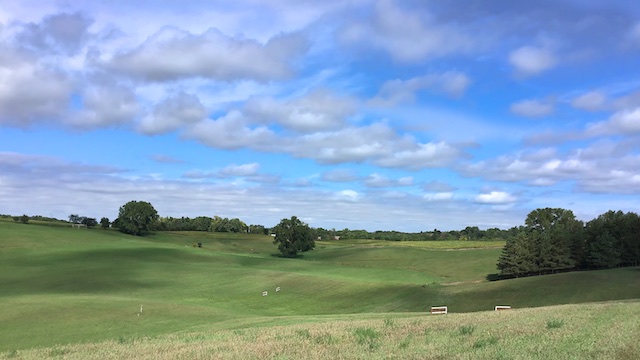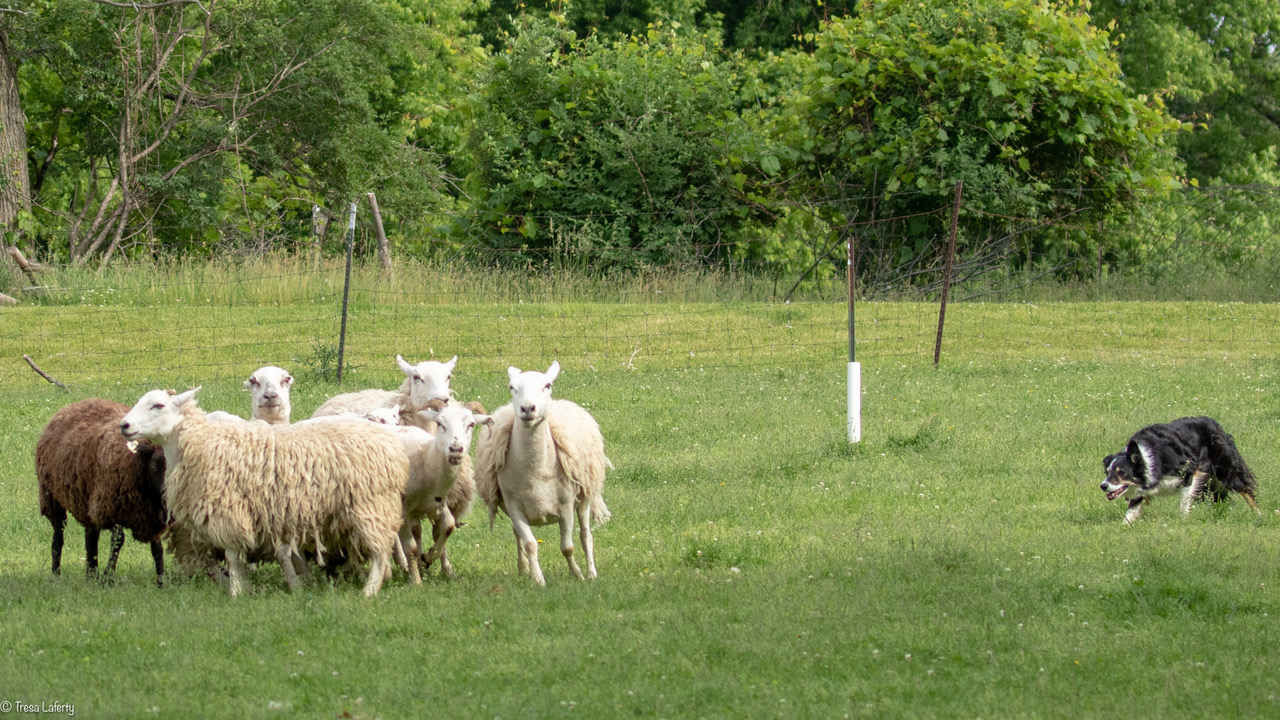Communication, Plus and Minus.
Bark magazine recently had an interesting article about a dog trained to a series of vibrations instead of verbal or visual cues. Tai, a Labrador retriever, wears a vest that allows the handler to signal him through different types of vibrations–pulsed or steady–placed above different legs. In other words, a pulsed vibration over the right front leg might mean back up, a steady one over the left hind might mean lie down. (Note to those of you going on electric collar alert (pretty much like I did): These are truly described as vibrations, similar to what you feel when your phone is on vibrate.)
An expensive motorized vest is hardly something that most of us need or want for our dogs, but it could be a boon for dogs working in noisy environment. If a dog can’t see you and it’s too noisy to use verbal signals, then this could be a wonderful addition to the many ways we communicate with dogs. The primary suggested use is in search and rescue operations, where it can be challenging for highly-focused dogs to hear their handlers.
This got me thinking about all the ways we communicate with dogs, and how each modality has its advantages and disadvantages. I found it instructive to think about how those impact on my communication with my own dogs; I’m hoping you will too.
VISUAL SIGNALS The plus here is that visual signals are of primary importance to dogs and are a great way to communicate. Unless your dog is laser focused on something else–the sheep, or a mouse, or the piece of pizza on the carpet–she’s paying attention to the slightest move that you make every time you interact. In my Lost in Translation DVD I ask the audience to call out whether I’m leaning forward or backward, and then do my best to move no more than a quarter of an inch. The can tell which way I’m leaning every time–salient visual signals can be miniscule and still be incredibly powerful.
The challenge is that we humans are often unaware of how we are moving our bodies, in part because we are so focused on speech and what we say. But we’re always cuing our dogs whether we know it or not, and our visual signals are often contrary to our verbal ones. That can lead to a lot of misunderstandings. I’m thinking about the owner who calls their dog to come, and then aggressively steps forward (as if to stop the dog). Or my inadvertently teaching my dogs to sit to a hand gesture without realizing it. We all know how important the tiniest change in, say, someone’s facial expression can be, and yet we often pay far too little attention to what we’re telling dogs with our bodies and our movements.
ACOUSTIC SIGNALS This, of course, is the modality we are most aware of using to communicate, and luckily, dogs are brilliant at learning to respond to a multitude of sounds. Dogs don’t have to be looking at us for this to work and can be good distance away as long as they can hear us. It doesn’t hurt that social canids like dogs and wolves use subtle changes in acoustic features to convey changes in meaning (a high-pitched growl versus a low-pitched one for example). In addition, we humans are able to produce a remarkable variety of noises to communicate with nuance and depth.
But ah, there’s the rub. That “remarkable variety” can get us into a lot of trouble. For one thing, we can say the same word a gazillion different ways. We might be focusing on the sound of each individual consonant and vowel, while the dog is attending to frequency. And then there’s that big vocabulary thing. How many ways are there to ask your dog to come back to you? Come! Here Here. Pup pup! Come Here! Come On. Daisy Come. Daisy. Get over Here. DaisyDaisyDAISY. DAISYDAMNIT . . .Etc. All of these things can, and have been, said by one of my clients. You may not be that extreme, but who of us hasn’t used sound inconsistently with our own dogs? This is my own biggest challenge; I can get lazy using synonyms or too many words for the same exercise, when I should be using one word, and one word only. Hmm. Time to make a note in my training journal to remind me that this is something to work on.
TOUCH Apart from the device mentioned above, we don’t tend to use touch as much to intentionally signal our dogs to do something, but we communicate through it none the less. We can touch dogs in ways that calm and support them–“You’re safe, I’m here”– or pet them in hopes it makes them feel happy and loved. Although less often than visual or verbal cues, we can ask them to do something with a touch too. When I say “Ready?” while touching Maggie’s paw, she picks it up in order for me to dry it off. I just experimented this morning, and sure enough, either one of those cues results in a lifted leg, although context was probably important. (We were where I always dry her off, I’ll have to try it in another area and see how well it’s generalized.)
The downsides of touch include its ability to communicate the wrong thing. For example, say you’re at the vet clinic, petting your dog. Except you’re even more nervous than he is, which is being clearly communicated by the way you are stroking him. Whoops. In addition, we may be touching our dogs in ways that they dislike, so rather than communicating love, we’re just eliciting irritation. Jeanette Cooperman wrote a great article in Bark magazine about how easy it is for us to semi-torture our dogs while we think we’re making them happy while we’re petting them.
All this reminds me how hard it is actually to communicate clearly. (This should not be a surprise to anyone with a partner, spouse, child, parent or best friend.) I’ve been doing a good job lately of taking notes on Maggie’s training sessions; I’m going to pay extra attention to communication as I do so for the next few weeks.)
What about you? What modality do you find most challenging? Most rewarding?
MEANWHILE, back on the farm: Speaking of training sessions, Maggie and I are working hard to prepare for our second attempt at running in the Open class at a big sheepdog trial. There is soooo much to work on: Just finding the sheep almost twice as far away as what she’s used to is the first challenge. We have limited access to fields that have outruns even close to the distance we’ll face in Hudson at the Midwest Championship Sheepdog Competition. It usually takes most dogs a full season of running in different trials to get used to running in the most challenging class, so I see these next trials as training and valuable experience for both of us. Maggie has run on the course before, but in the intermediate class, and so will expect to find the sheep much closer than they will be. That’s confused a lot of dogs; we’ll see how Maggie does!
Here’s the course from a different perspective from where the dog and handler start. But it gives you an idea of how huge the course is, and how far away the sheep start at (at the very back of the field on the left, the handler will start on the far right, actually out of the picture). The good news is that Maggie has a naturally big outrun, and so she might be able to get herself to the sheep without extra help from me. But she runs so wide that she will probably lose sight of the sheep part way out because they’ll be behind a rise, and that well might bring her in before she gets behind the sheep. If she does, cross your paws that she’ll take a “redirect” from me, and run out farther and find the sheep.
Her next challenge is the “lift,” worth up to 10 whole points although only lasting a few seconds. It’s worth 10% of your score though, because it sets the stage for the rest of the run. The “lift” is when the dog turns in toward the sheep and takes charge of them. Dogs can come in hard like gang busters, charging in and scaring the sheep such that they end up fighting the dog the rest of the course. Or they can come with hesitation, so that the sheep decide they can do what they want. Ideally, a dog comes toward the sheep with a Can Do attitude but with enough finesse to not scare the sheep. My translation of these three styles is:
“Holy Crap! Get going! We’re a million miles from my human and I’m scared silly!”
versus
“Uh, excuse me. I don’t want to cause any trouble, but would you consider, well, maybe, if you’d like, if it would be okay, moving down the hill this way?”
versus
“Hello ladies! We’re going this way! Chop chop, let’s get going, a nice quick trot would be good.”
Here’s Maggie practicing “lifting” sheep off of a pan of corn at a Scott Glen clinic. It is, of course, extra hard to move sheep off of their favorite food, but more and more trials are setting sheep out by putting down a pan of grain. Maggie got a lot better at it, and I’m hoping it’s another way of giving her more confidence.
Maggie falls somewhere between #2 and#3, depending on how she is feeling and the sheep themselves. Regretably, she had a big set back at a recent training session, and was so upset she actually quit working the next session. (Maggie has tremendous talent, but is far too easily upset by minor issues. In this case, another dog simply came and “took the sheep” away while she was working them due to a mis communication. That would have no effect on most dogs but it threw Maggie for a loop, and on our next attempt the sheep couldn’t be settled for Maggie to do a lift, and the dog working around her rattled her even more.) Two more sessions later, at a good friends with very cooperative sheep, and she was keen again, but still hesitant once it was time to do the drive section of the course.
My primary job now is to boost her confidence. Maggie has a lot of skill, but very little confidence, so I’m not going to worry much about trying to get a great score on the drive at Hudson, IF we get to it. My goal is for her to 1) find the sheep, even if I have to give her a lot of extra help, and 2) have the confidence to pick them up at the lift and bring them down the field to me. (They will possibly try to run back to the pens from where they came where their friends are. Maggie will have to put her big girl pants on and not let that happen.) If she gets the sheep down the field to me, it would be great if we get a good start on a drive and complete all three legs of it, even if sloppily. Most importantly, it’s important that she enjoy herself and learns to be comfortable working so far away from me.
What are you working on this week? Whatever it is, I hope it goes well. I’ll write about the results of the trial next week. (And if you find all this sheepdog stuff boring, please don’t hesitate to say so, in some kind, benevolent way of course. But I’d really like to know . . .)







Post a Comment